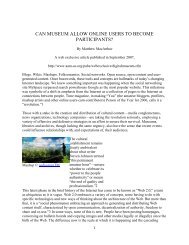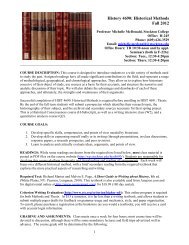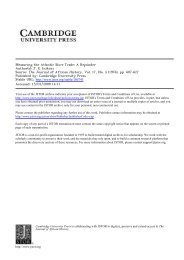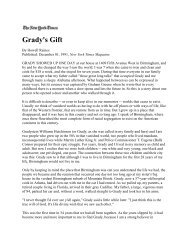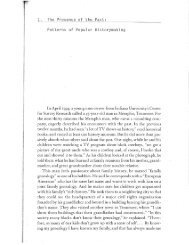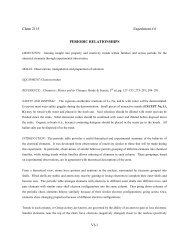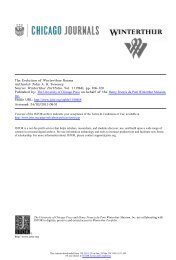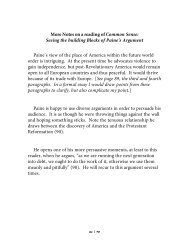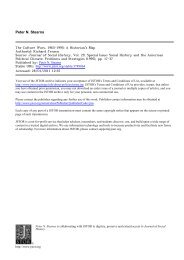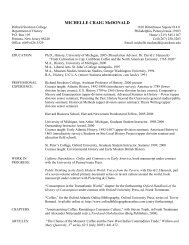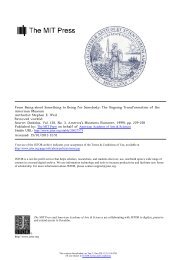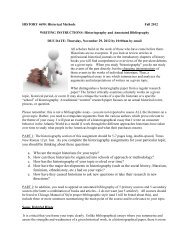What Is the Object of This Exercise? A Meandering Exploration of ...
What Is the Object of This Exercise? A Meandering Exploration of ...
What Is the Object of This Exercise? A Meandering Exploration of ...
Create successful ePaper yourself
Turn your PDF publications into a flip-book with our unique Google optimized e-Paper software.
182 Elaine Heumann Gurian<br />
public according<br />
to accepted standards; have a formal and<br />
appropriate program <strong>of</strong> documentation, care, and use <strong>of</strong> collec<br />
tions and/or tangible objects.<br />
. . ."5<br />
For <strong>the</strong> visitor, it is <strong>the</strong> experience <strong>of</strong> simultaneously being<br />
in<br />
a social and <strong>of</strong>ten celebratory space while focusing<br />
on a multi<br />
sensory experience that makes a museum effective. Virtual<br />
experiences<br />
in <strong>the</strong> privacy <strong>of</strong> one's home may be enlightening<br />
but, I think,<br />
are not part <strong>of</strong> <strong>the</strong> civilizing experience that muse<br />
ums<br />
provide.<br />
It is <strong>the</strong> very materiality <strong>of</strong> <strong>the</strong> building, <strong>the</strong><br />
importance <strong>of</strong> <strong>the</strong> architecture, and <strong>the</strong> prominence that cities<br />
give<br />
to museum location that toge<strong>the</strong>r make for <strong>the</strong> august<br />
place that museums hold. Congregant space will, I believe,<br />
remain a necessary ingredient <strong>of</strong> <strong>the</strong> museum's work.<br />
The objects that today's museums<br />
responsibly<br />
care for, pro<br />
tect, and cherish will remain central to <strong>the</strong>ir presentations. But<br />
<strong>the</strong> definition <strong>of</strong> "objectness" will be broad and allow for every<br />
possible method <strong>of</strong> storymaking. These more<br />
broadly defined<br />
objects range from hard evidence to mere props and ephemera.<br />
I<br />
hope<br />
I have shown that objects<br />
are<br />
certainly<br />
not<br />
exclusively<br />
real nor even<br />
necessarily "tangible" (even though <strong>the</strong> AAM<br />
uses that word). For it is <strong>the</strong> story told, <strong>the</strong> message given, and<br />
<strong>the</strong> ability <strong>of</strong> social groups to<br />
experience it toge<strong>the</strong>r that pro<br />
vide <strong>the</strong> essential ingredients <strong>of</strong> making<br />
a museum<br />
important.<br />
Museums are social-service providers (not always by doing<br />
direct social-service work, though many do that), because <strong>the</strong>y<br />
are spaces belonging<br />
to <strong>the</strong> citizenry<br />
at<br />
large, expounding<br />
on<br />
ideas that inform and stir <strong>the</strong> population<br />
to<br />
contemplate and<br />
occasionally<br />
to act.<br />
Museums are not<br />
unique<br />
in <strong>the</strong>ir work. Ra<strong>the</strong>r, <strong>the</strong>y share a<br />
common purpose with a host <strong>of</strong> o<strong>the</strong>r institutions. We need<br />
museums and <strong>the</strong>ir siblings because we need collective history<br />
set in congregant locations in order to remain civilized. Societ<br />
ies build <strong>the</strong>se institutions because <strong>the</strong>y au<strong>the</strong>nticate <strong>the</strong> social<br />
contract.<br />
They<br />
are collective evidence that we were here.<br />
<strong>This</strong> content downloaded on Tue, 15 Jan 2013 12:26:43 PM<br />
All use subject to JSTOR Terms and Conditions



